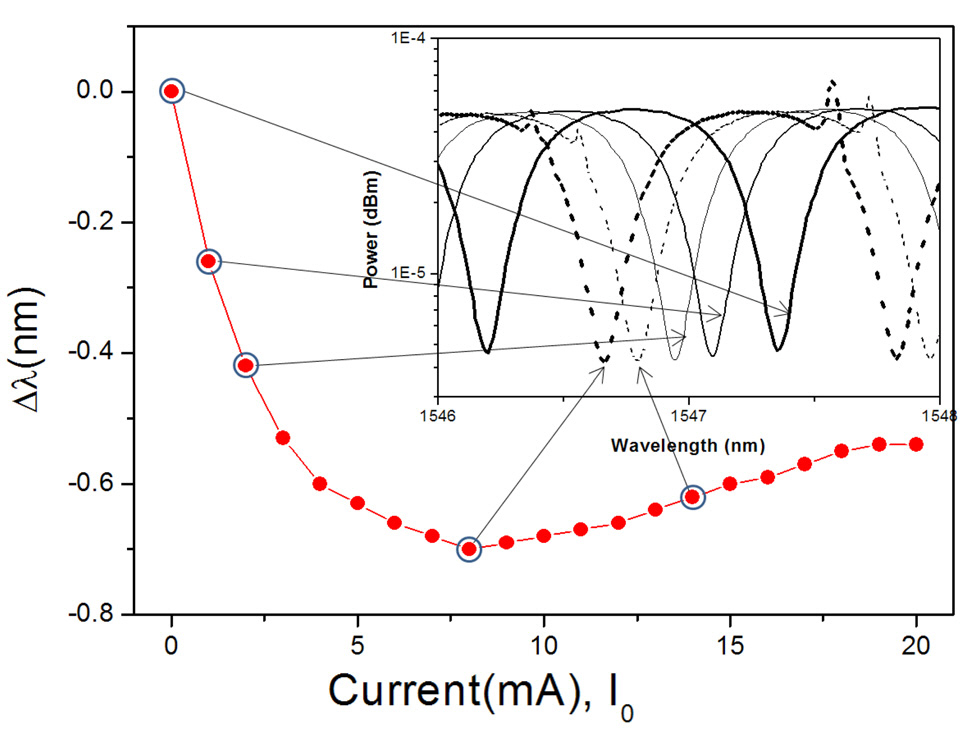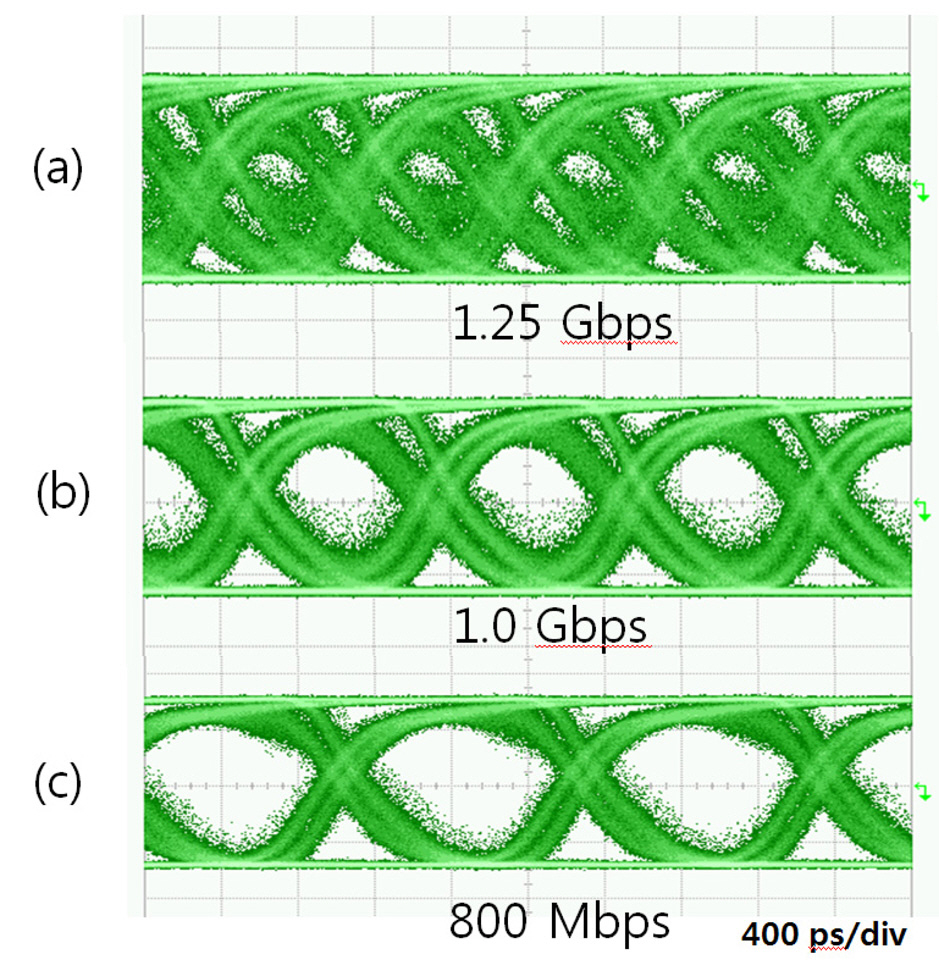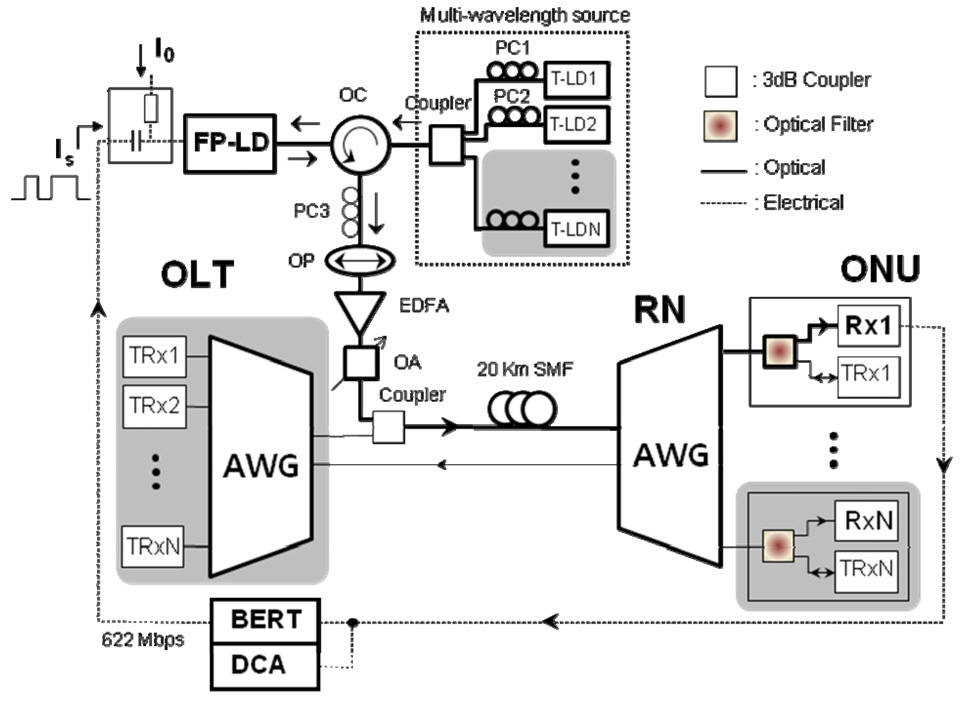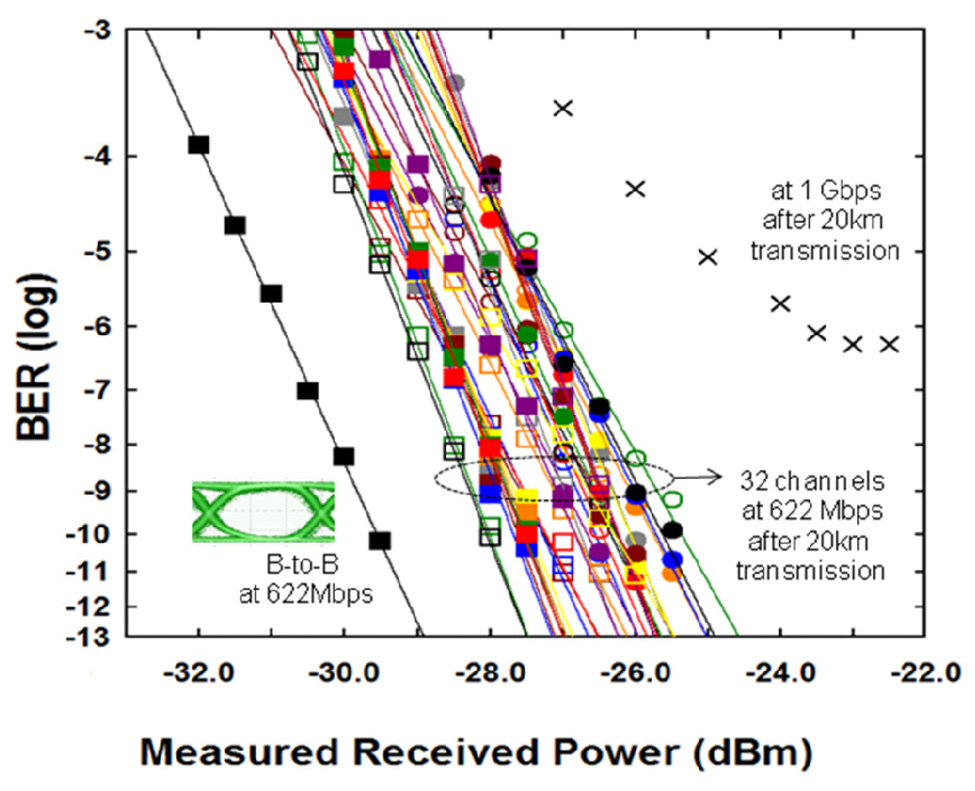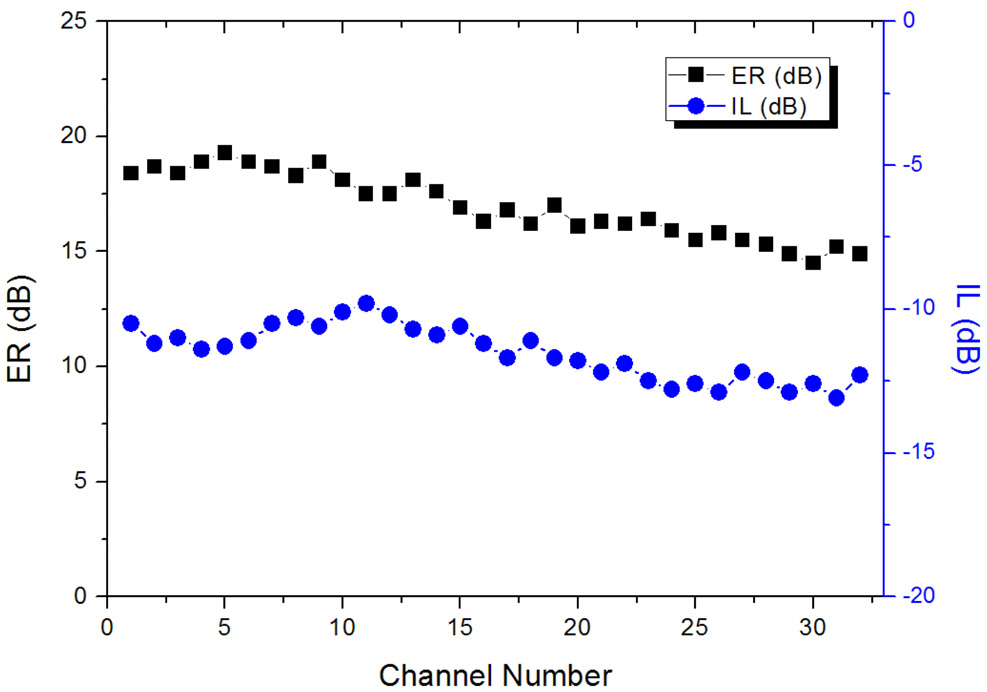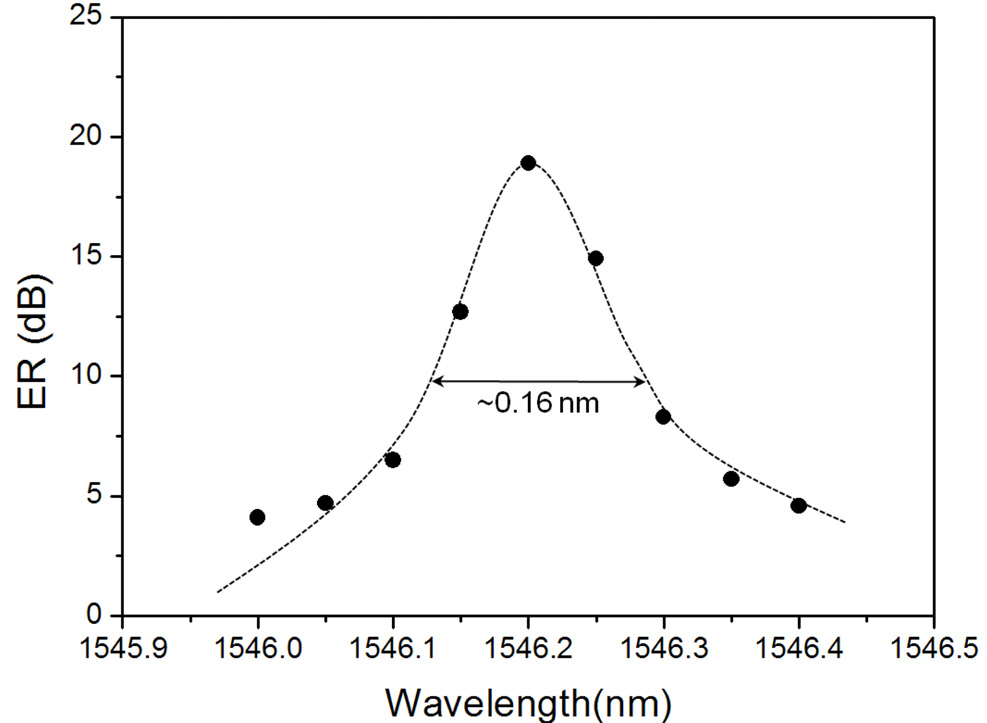



An external optical modulation using absorption nulls in a Fabry-Perot laser diode (FP-LD), has been proposed and experimentally demonstrated for multicasting in a WDM-PON. The center wavelengths of absorption nulls in an FP-LD move to short-wavelength rapidly by only a small current (~1 mA) injection.If the current injection is stopped, the nulls move back to the original position. Such a movement of the nulls can make the FP-LD act as an external optical modulator, which is found to modulate at a maximum modulation speed of 800 Mbps or more. For a multicasting transmitter in a WDM-PON, the proposed modulator can be cost-effectively applied to a multi-wavelength laser source with the same periodicity of the longitudinal mode. Instead of the multi-wavelength laser source, tunable-LDs are used for experiments.The 32 channel multicasting system with the proposed modulator has been demonstrated, showing power penalties of 1.53~4.15 dB at a bit error rate of 10-9 with extinction ratios better than 14.5 dB at 622 Mbps.
Recently, Wavelength Division Multiplexing (WDM)-Passive Optical Network (PON) for optical access networks has received a great deal of an attention. WDM-PON has a high security,a protocol transparency, and a wide bandwidth compared with Time Division Multiplexing (TDM)-PON. However, it requires an expensive wavelength specified optical source such as a distributed feedback laser to maintain an assigned wavelength [1]. To solve the problem, several optical sources[2, 3], color-free and low cost have been proposed. However,even though virtual point-to-point connections with such optical sources can be made cost-effectively, it is inherently difficult to provide a multicasting (or broadcasting) function.Thus, optical sources for multicasting [4, 6] or several multicasting overlay schemes [7, 8] have been actively studied.In [4], a spectrum sliced amplified spontaneous emission(ASE) source has been proposed for multicasting but it requires an expensive external modulator and shows limited performance. The mutually injected Fabry-Perot Laser Diodes(FP-LDs) [5] and the side-mode suppressed multi-wavelength fiber laser [6] are good candidates. However, they require a sophisticated alignment method for a short cavity length,and still need an expensive optical modulator if not directly modulated. For the multicast overlay schemes [7, 8], both point-to-point and multicast connections can be simultaneously constructed by using a single optical source. However,a complicated coding scheme and a synchronized controller are required. Moreover, expensive external modulators still make the system complex and costly.
In the previous work [9], an external optical modulator employing a low-cost multiple-quantum-well (MQW) FP-LD has been proposed. The work is based on the absorption null modulation and extended to wavelength converters in other previous works [10, 11]. In this paper, further experiments have reported that it is possible for the proposed FP-LD modulator to have more than 622 Mbps modulation speed and to apply to multicasting transmission in a WDM-PON.
II. EXTERNAL MODULATION USING AN FP-LD
The proposed FP-LD modulator works under threshold current. Its basic principle is as followings: As the current of the FP-LD increases from 0 mA to threshold current,absorption nulls move to short-wavelength without any lasing on the TM-mode. Meanwhile, the FP-LD on the TE-mode makes very little light by spontaneous emission. Only a small current can move the absorption nulls enough to modulate optical signals. If the current injection is stopped,the nulls move back to the original position. Such a movement can make the FP-LD act as an external optical modulator.A previous work [9] has already shown that the absorption nulls in an FP-LD are used for optical modulation on both TM- and TE-modes at the data rate of 155 Mbps. However,there are no results to report determining the maximum speed of modulation.
Fig. 1 shows the experimental setup for optical modulation by an FP-LD. The FP-LD is an InGaAsP MQW type, and has a nominal wavelength of 1549.5 nm and longitudinal mode spacing of 1.16 nm. Also it has the threshold current of ~8 mA. To observe absorption nulls spectra, an amplified spontaneous emission (ASE) source with a bandwidth of~26 nm is replaced at the position of the T-LD in Fig. 1.The broadband ASE light enters the FP-LD via the polarization controller1 (PC1) and the optical circulator (OC).By controlling the PC2, only a TM-mode beam can be set to pass through the optical polarizer (OP). As can be seen from the inset figure of Fig. 2, absorption nulls are observed with spacing of ~1.16 nm, which is almost the same as the lasing mode spacing. with increased current injection,the TM-mode absorption nulls rapidly move to short-wavelengths.However, for current over the threshold (~8 mA),the nulls gradually move back to the long-wavelength due to the thermal effect from lasing [12]. At the beginning for modulation, the incident light is spectrally aligned at the center wavelength of one among the absorption nulls with no bias current. The bias current makes the nulls move to short-wavelengths. As seen from the data in Fig.2, a current injection of only ~1 mA can make ~0.26 nm wavelength shift for the nulls. Thus, by applying the current on/off, the nulls move back and forth to modulate the optical signal. The wavelength shift of 0.26 nm is equal to ~32.5 GHz, which is enough to modulate the optical signal at 622 Mps.
The shift of the absorption nulls comes from the change of the refractive index in an MQW FP-LD waveguide,which is due to anomalous dispersion, plasma effects, and bandgap shrinkage [13]. However, the bandgap shrinkage can be neglected when an input light wavelength is longer than a bandgap wavelength of the waveguide in the MQW FP-LD [14]. By the calculation of the rate equation for the carrier density N, the modulation speed can be roughly estimated as 630 Mbps ~ 1 Gbps [9]. To know the maximum speed of modulation for the FP-LD used in this experiment,0.8, 1.0, and 1.25 Gbps modulations are tested and Fig. 3 shows the oscilloscope traces for the three data rates. It is seen that the maximum speed of modulation is about 800 Mbps. To get higher modulation speed (around 1.0 Gbps),careful design of the electrode in the FP-LD and smaller current injection might be needed.
III. EXPERIMENTAL RESULTS FOR MULTICASTING
Fig. 4 shows the experimental setup for multicasting in a WDM-PON using the proposed FP-LD optical modulator.For cost-effectiveness of the multicasting, a multi-wavelength laser source [5, 6] with the same periodicity as the longitudinal mode should be used. However, due unavailability for the multi-wavelength source in the laboratory, the tunable-LDs are used as shown in Fig. 4. It seems reasonable to suppose that this paper focuses only on the possibility of an external optical modulator for multicasting using an FP-LD.
The gray colored blocks show the conceptual scheme for a WDM-PON system. The blocks are not constructed in this experiment. The FP-LD generally has absorption nulls on the TM-mode. The absorption nulls are made by being kept and dissipated in an FP-LD cavity for the input light with wavelength such that the phase after each round trip has to be an integral multiple of 2π . In other words,λp=2nL/p, where λp is the wavelength of the pth cavity mode, L is the cavity length. By some manipulations, the spacing between two adjacent modes as this, λp - λp+1 ?λ2/2nL [15]. The null spacing for the InGaAsP MQW FP-LD used in this experiment is around 1.16 nm as shown in Fig. 2, corresponding to cavity length of ~296 ㎛(by using
The proposed FP-LD modulator can be operated in two modes [9], i.e. a non-inverting and inverting mode. For the non-inverting signal, at current ‘0’ level, the center wavelength of an absorption null is initially aligned to the wavelength of the external incident light. On the other hand,for the inverting signal, when the current is ‘1’ (high), the center wavelength of an absorption null should be exactly aligned to the wavelength of the external incident light.Therefore, it is easier to obtain high Extinction Ratio (ER)in the non-inverting mode rather than the inverting mode.Thus, all the experiments in this paper were conducted on the non-inverting mode.
In Fig. 4, the CW lights from T-LD1 and T-LD2 are sent to the FP-LD modulator, which are modulated at 622 Mbps (231-1 PRBS). Here, the polarization of the CW lights should be aligned on the TM-mode by adjusting PC1 and PC2. The 622 Mbps modulated signal is sent to the optical coupler through OC, PC3, OP, EDFA, and the optical attenuator (OA) as shown in Fig 4. After passing through a 20 km single mode fiber (SMF), the signal is wavelength-demultiplexed to one of the optical network units(ONUs) by the 32 channel AWG located at the remote node (RN). Although only two sources, i.e. T-LD1 and T-LD2, are used in this multicasting experiment, the BERs for all the channels of the AWG can be measured by tuning the wavelength of the T-LD1 and T-LD2. Also, a thermoelectric cooler/heater (TEC) controller in the AWG module is adjusted to align to the center wavelength of the FP-LD’s nulls. The insertion loss of the SMF is about 4.6 dB. The 32-channel AWG device has a channel spacing and a 3 dB width of 100GHz and ~30 GHz, respectively. Fig. 5 shows bit error rate (BER) measurements after 20 km transmission for 32-channels at 622 Mbps. The power penalties are observed from 1.53 to 4.15 dB compared to the back-toback at a BER of 10-9. On the other hand, 1.0 Gbps modulation shows the error floor at a BER of 10-6.
In order to know the performances of the proposed FP-LD modulator, the extinction ratios (ERs) and insertion losses(ILs) for 32-channels of the AWG at 622 Mbps are measured and are shown in Fig. 6. The proposed FP-LD modulator shows comparatively good performances, i.e. ERs > 14.5 dB and ILs < 13.1 dB. Also, to investigate the wavelength sensitivity of the proposed FP-LD modulator, the ERs according to the wavelength change of input beam are measured while the nulls of the FP-LD are fixed. Fig. 7 shows the result of the wavelength sensitivity, which the ER of more than 10 dB is obtained for a wavelength variation of 0.16 nm (~20 GHz). It is simple to lock the frequency of a distributed feedback LD used in an optical communication system within 10 MHz [16].
If a 1300 nm FP-LD is used, 1300 nm and 1500 nm wavelength light will be simultaneously modulated. This is because the FP-LD with gain in the 1300 nm region is transparent to 1550 nm light [17]. Even though current injection leads to a change of effective refractive index in the 1300 nm region,1300 nm as well as 1550 nm light experiences the shift of absorption nulls. From the results, the proposed modulator is likely to be a good candidate for ultra broadband multicasting with a low cost in a WDM-PON.
In this paper, a new optical modulation method for multicasting using a low-cost FP-LD has been proposed and experimentally demonstrated. For 32 multicasting channels,the measured ERs and ILs were more than 14.5 dB and less than 13.1 dB, respectively. Also, the maximum and minimum of measured power penalties at a bit error rate of 10-9 were 1.53 and 4.15 dB. Although the multicasting experiment in this paper has been conducted at the data speed of 622 Mbps, it may be possible to get around 1.0 Gbps modulation speed by concisely controlling injection current and designing the electrode of the FP-LD. Moreover,if a 1300 nm FP-LD is used as the proposed optical modulator, wideband operation will be working in the wavelength range of 1300 nm to 1550 nm.

